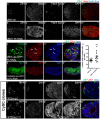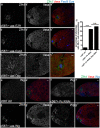Repression of Abd-B by Polycomb is critical for cell identity maintenance in adult Drosophila testis
- PMID: 28698559
- PMCID: PMC5506049
- DOI: 10.1038/s41598-017-05359-0
Repression of Abd-B by Polycomb is critical for cell identity maintenance in adult Drosophila testis
Abstract
Hox genes play a fundamental role in regulating animal development. However, less is known about their functions on homeostasis maintenance in adult stem cells. Here, we report that the repression of an important axial Hox gene, Abdominal-B (Abd-B), in cyst stem cells (CySCs) is essential for the homeostasis and cell identity maintenance in the adult Drosophila testis. Derepression of Abd-B in CySCs disrupts the proper self-renewal of both germline stem cells (GSCs) and CySCs, and leads to an excessive expansion of early stage somatic cells, which originate from both lineages. We further demonstrate that canonical Polycomb (Pc) and functional pathway of Polycomb group (PcG) proteins are responsible for maintaining the germline cell identity non-autonomously via repressing Abd-B in CySCs in the adult Drosophila testis.
Conflict of interest statement
The authors declare that they have no competing interests.
Figures






Similar articles
-
Polycomb group genes Psc and Su(z)2 maintain somatic stem cell identity and activity in Drosophila.PLoS One. 2012;7(12):e52892. doi: 10.1371/journal.pone.0052892. Epub 2012 Dec 21. PLoS One. 2012. PMID: 23285219 Free PMC article.
-
The Hox gene Abd-B controls stem cell niche function in the Drosophila testis.Dev Cell. 2014 Jan 27;28(2):189-202. doi: 10.1016/j.devcel.2013.12.016. Dev Cell. 2014. PMID: 24480643
-
Jak-STAT regulation of cyst stem cell development in the Drosophila testis.Dev Biol. 2012 Dec 1;372(1):5-16. doi: 10.1016/j.ydbio.2012.09.009. Epub 2012 Sep 23. Dev Biol. 2012. PMID: 23010510 Free PMC article.
-
Polycomb complexes in stem cells and embryonic development.Development. 2013 Jun;140(12):2525-34. doi: 10.1242/dev.091553. Development. 2013. PMID: 23715546 Review.
-
Stage-specific control of stem cell niche architecture in the Drosophila testis by the posterior Hox gene Abd-B.Comput Struct Biotechnol J. 2015 Jan 21;13:122-30. doi: 10.1016/j.csbj.2015.01.001. eCollection 2015. Comput Struct Biotechnol J. 2015. PMID: 25750700 Free PMC article. Review.
Cited by
-
Mitochondrial genotype alters the impact of rapamycin on the transcriptional response to nutrients in Drosophila.BMC Genomics. 2021 Mar 24;22(1):213. doi: 10.1186/s12864-021-07516-2. BMC Genomics. 2021. PMID: 33761878 Free PMC article.
-
The complex role of transcription factor GAGA in germline death during Drosophila spermatogenesis: transcriptomic and bioinformatic analyses.PeerJ. 2023 Jan 9;11:e14063. doi: 10.7717/peerj.14063. eCollection 2023. PeerJ. 2023. PMID: 36643636 Free PMC article.
-
Epigenetic regulation of drosophila germline stem cell maintenance and differentiation.Dev Biol. 2021 May;473:105-118. doi: 10.1016/j.ydbio.2021.02.003. Epub 2021 Feb 18. Dev Biol. 2021. PMID: 33610541 Free PMC article. Review.
-
Epigenetic dynamics during germline development: insights from Drosophila and C. elegans.Curr Opin Genet Dev. 2023 Feb;78:102017. doi: 10.1016/j.gde.2022.102017. Epub 2022 Dec 20. Curr Opin Genet Dev. 2023. PMID: 36549194 Free PMC article. Review.
-
Hox genes limit germ cell formation in the short germ insect Gryllus bimaculatus.Proc Natl Acad Sci U S A. 2019 Aug 13;116(33):16430-16435. doi: 10.1073/pnas.1816024116. Epub 2019 Jul 25. Proc Natl Acad Sci U S A. 2019. PMID: 31346080 Free PMC article.
References
Publication types
MeSH terms
Substances
LinkOut - more resources
Full Text Sources
Other Literature Sources
Molecular Biology Databases
Research Materials

